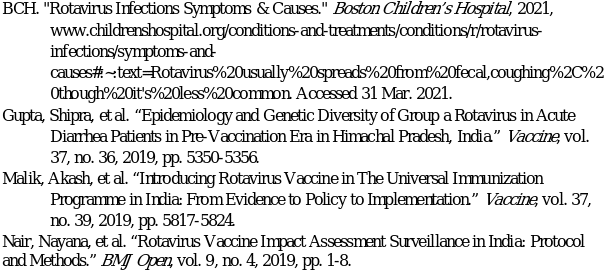- Rotavirus is a highly contagious viral agent, which directly target a person’s intestinal lining.
- The most vulnerable population are children.
- The virus causes a severe case of diarrhea.
- The complication is dehydration or lack of water within the body.
- The disease requires an immediate hospitalization.
Statistics in India
- Rotavirus in India is a major cause of all moderate to severe forms of diarrhea.
- Among children younger than 23 months, it accounts for 24%.
- Among children with ages between 24 and 59 months, it accounts for 13% (Nair et al. 1).
- In total, gastroenteritis caused by rotavirus affects 11.4 million children, who are under five-years-old.
- The disease causes 872 000 hospitalizations per year (Nair et al. 1).
- An epidemiological study from India suggests that rotavirus leads to more complications of gastroenteritis than non-rotavirus forms (Gupta et al. 5350).
- The table from the study showcases that the infection is statistically prevalent among ages 6-11.
- Despite the non-rotavirus groups being larger than the rotavirus one, the severity is equivalent and even greater in the latter.
- In addition, moderate severity is more common in the non-rotavirus group.
- Therefore, rotavirus is a major public health issue in India.
Causes
- The main cause of rotavirus infection is the virus.
- The most common form of transmission of the virus is through a fecal-oral contact.
- Poor hygiene, such as improper washing of hands, is the main factor.
- In addition, water and food contamination also contribute to the overall spread.
- On rare instances, coughing and sneezing can also lead to the transmission (BCH).
Prevention
- The most effective preventative measure is vaccination.
- Immunization prevents complications and infections among children, who are the most susceptible to the disease.
- “In 2016, India became one of the first countries in Asia to introduce an indigenously manufactured rotavirus vaccine” (Malik et al. 5817).
- The prevention also include governmental regulation and management of immunization process through proper surveillance and monitoring.
- The study shows that the overall implementation of vaccination programs in India is not comprehensive.
- Some regions are at different phases (Malik et al. 5820).
- Phase 1 – four regions – green.
- Phase 2 – four regions – blue.
- Phase 3 – one region – yellow.
Rotavirus in the World
- It is important to note that rotavirus globally accounts for 125 000 000 or 125 million cases of diarrhea (BCH).
- The mortality rate worldwide is around 600 000.
- It is stated: “Rotavirus infection accounts for 39% of under-five diarrhoeal deaths globally and 22% of these deaths occur in India” (Nair et al. 1).
Rotavirus in the United States
- Rotavirus causes around 55 000 hospitalizations among children per year in the United States (BCH).
- However, the overall mortality rate ranges between 20 and 40 deaths per year (BCH).
- In other words, the death rate is significantly lower in the US than in India, which is around 130 000.
- In addition, the hospitalization rate is also higher in India factoring-in the population differences (Nair et al. 3).
References
